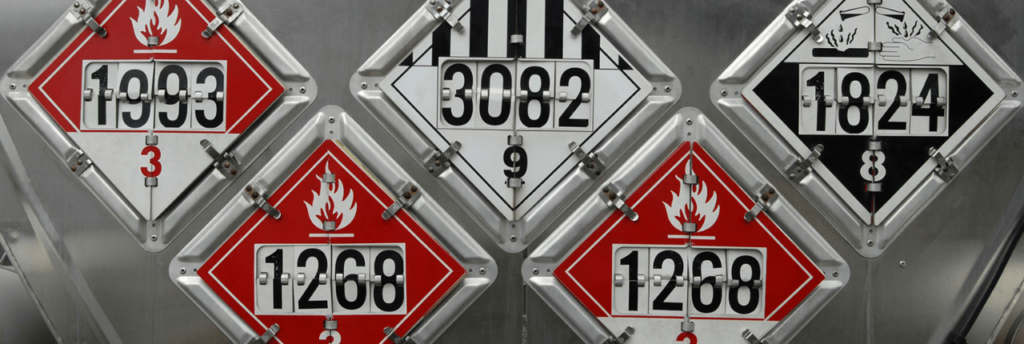Many of our clients have come to us in the past for assistance with shipping dangerous items. At first glance, this can seem like a very daunting process. This blog will hopefully help to unravel some of the mystery around the packaging and transport of dangerous goods.
What are dangerous goods?
Before we look at anything else, we should identify all the different types of “dangerous goods.” These are defined by the UN. Proper classification of goods being shipped is very important so every link in the supply chain knows exactly how to deal with those items. It also means the emergency services can safely deal with any issues that may arise.
| Class of material | Type of material |
|---|---|
| 1 | Explosive substances and articles |
| 2.1 | Flammable gas (for example butane) |
| 2.2 | Non-flammable and non-toxic gases which could cause asphyxiation (for example nitrogen, helium, carbon dioxide) or oxidisers (for example oxygen) |
| 2.3 | Toxic gases (for example chlorine, phosgene) |
| 3 | Flammable liquids (for example lighter fluid, petrol) |
| 4.1 | Flammable solids, self-reactive substances and solid desensitised explosives |
| 4.2 | Substances liable to spontaneous combustion |
| 4.3 | Substances which, in contact with water, emit flammable gases |
| 5.1 | Oxidising substances |
| 5.2 | Organic peroxides |
| 6.1 | Toxic substances |
| 6.2 | Infectious substances |
| 7 | Radioactive material |
| 8 | Corrosive substances |
| 9 | Miscellaneous dangerous substances and articles |
Whilst a lot of items in this list come under the same rules, it should be noted that for any clinical waste, you will need to be registered with a hospital or veterinary surgery.
The person responsible for shipping the goods (consignor) is ultimately responsible for making sure the item is labelled and packaged correctly. The penalties for incorrect labelling and other issues can be quite severe, so it is essential the process is done properly.
Do I need a DGSA?
Before you can think about shipping your item, you need to think about the need to appoint a DGSA (Dangerous Goods Safety Advisor). Businesses that handle, process or transport dangerous items on a regular basis must have one of these. There are a few exceptions to this rule, which include:
- Infrequent transport, such as with breakdown recovery vehicles.
- You are the party receiving the goods.
- The goods are in limited quantities.
- The goods are being moved a very short distance by road, such as within an industrial estate.
- Private vehicles are being used for transport.
You can either appoint a member of staff within your business as a DGSA or hire a specialist company. If you intend to appoint someone at your company, they will need to obtain a certificate after training and pass a written examination approved by the DfT (Department for Transport). Training courses are usually run by independent providers and can vary from 2 to 5 days. Of course, if you use John Pipe International to support you, we will cover this requirement on your behalf.
What about different types of transport?
Road
This is regulated by the European Agreement concerning the International Carriage of Dangerous Goods by Road (ADR). Specific information can be found here.
Sea
Dangerous goods transported by sea are covered by the International Maritime Dangerous Goods code (IMDG). The IMDG code can be found here.
Air
Air transport is covered by the International Civil Aviation Organization (ICAO) and their Technical Instructions. Publications and more information can be found on the Civil Aviation Authority (CAA) website. Unlike other forms of transport, dangerous goods training is a mandatory requirement for anyone involved in transporting dangerous goods by air. More information about the training required can also be found on the CAA website.
What documentation and labeling do I need?
When you are transporting dangerous items, your shipment must be accompanied by a document that declares the nature and description of your goods. An example of a type of
form that might be used can be found here. Additional paperwork could also be needed depending on the method of transport used, and this can be found in the regulations for those types of transport.
Items should also be labelled in accordance with internationally recognised marks that specify what type of hazard the goods are. Some of these symbols and labels can be found here.
How about packaging?
Dangerous goods can be some of the most difficult sorts of items to package correctly, so it is very important this is done correctly. Most dangerous goods items require packaging designed and constructed to UN standards and should be capable of passing tests (such as drop tests, being subjected to pressure or being held in stacks). It should also meet the needs of the hazardous item contained inside.
Getting started
As a specialist in tailor-made packaging for all types of hazardous goods, John Pipe International can help you with your packing needs. Our team members are experienced with handling all types of dangerous items, and we have suitable facilities. As well as conventional packaging solutions, we offer bespoke solutions such as custom shipping cases, which are ideal for fragile, high value, or dangerous items.
To get in touch and speak to a member of our team, simply use the form on our website or give us a call. We will be happy to assist you with your packing and logistics needs. We hope this article was helpful.

